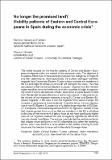Por favor, use este identificador para citar o enlazar a este item:
http://hdl.handle.net/10261/219880COMPARTIR / EXPORTAR:
 SHARE
BASE SHARE
BASE
|
|
| Visualizar otros formatos: MARC | Dublin Core | RDF | ORE | MODS | METS | DIDL | DATACITE | |

| Título: | No longer the promised land? Mobility patterns of Eastern and Central Europeans in Spain during the economic crisis |
Autor: | González Ferrer, Amparo CSIC ORCID ; Stanek, Mikołaj CSIC ORCID | Palabras clave: | Spain Central Eastern Europe nationals Return migrations Economic crisis Free movement of the labour force |
Fecha de publicación: | 2016 | Editor: | Centro Studi Emigrazione | Citación: | Studi Emigrazione 53 (202): 193-215 (2016) | Resumen: | This article focuses on the mobility patterns of Central and Eastern European immigrants within the context of the economic crisis. The objective is to explore differences in these patterns between two categories of migrants and their determinants. More specifically, the authors distinguish between migrants from Central and Eastern Europe whose countries are members of the EU and migrants whose countries do not belong to the union. The initial assumption is that Central and Eastern European migrants from EU member states would be more inclined to return to their countries of origin as opportunity costs of such a decision are smaller. Descriptive analysis based on data from Residential Variation Statistics is rather inconclusive. In absolute terms, the volume of out-migration increases among EU Central and Eastern European migrants. In the case of non-EU migrants from Eastern Europe, the increase in departures is more moderate. In relative terms, the out-migration rate of non-EU Eastern Europeans is only slightly larger than that of EU Eastern Europeans. Statistical analysis based on OLS regression models shows that migrant groups from countries that are members of the EU and belong to the area of free movement of labour force do not have significantly higher rates of out-migration. Instead, the rate of regularity significantly affects the intensity of exits from Spain. The authors conclude that the institutional factor that shapes return decisions is not EU citizenship, but rather the residency permit, which may itself be a value added to the mobility allowing for both return and the freedom to travel within the whole Schengen Area | Descripción: | Con autorización de la revista para autores CSIC | Versión del editor: | http://www.cser.it/scientific-journal/ | URI: | http://hdl.handle.net/10261/219880 | ISSN: | 0039-2936 |
| Aparece en las colecciones: | (CCHS-IEGD) Artículos |
Ficheros en este ítem:
| Fichero | Descripción | Tamaño | Formato | |
|---|---|---|---|---|
| mobility_europeans_spain.pdf | Artículo | 346,5 kB | Adobe PDF |  Visualizar/Abrir |
CORE Recommender
Page view(s)
143
checked on 19-abr-2024
Download(s)
133
checked on 19-abr-2024
Google ScholarTM
Check
NOTA: Los ítems de Digital.CSIC están protegidos por copyright, con todos los derechos reservados, a menos que se indique lo contrario.
